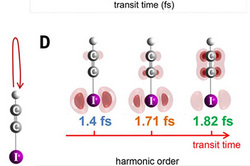 An international team of scientific workers for the first time tracked in real time the movement of the electron in the molecule and showed that this process can be controlled. An international team of scientific workers for the first time tracked in real time the movement of the electron in the molecule and showed that this process can be controlled.
The results of the study presented in the journal Science, and briefly about them tells in a press release MIPT, arrived in edition "Tapes.ru".
The experiments took place in the framework of attivisti - field of science that studies phenomena with attosecond duration (continued billionth of a billionths of a second). Using attivisti scientists want to track the ultrafast motion of electrons in molecules (rearrangement of their electron shells). These processes - the key to understanding the chemical and biochemical reactions, as the formation of new chemical bonds and is in a "redistribution" of electrons.
Scientists from Russia, Denmark, Belgium and Canada under the baton of Hans Jakob wö²rner from ETH in Zurich previously demonstrated the ability of such studies. In recent experiments they have been able actually to trace the movement of electrons with a temporal resolution of 100 attoseconds and demonstrate that you can manage them.
In experiment were used the molecules of iodization (HCCI), which represent a long chain of 4 atoms hydrogen, 2 atoms of carbon and iodine atoms. Under the action of extremely powerful and short laser pulses, the configuration of the electron shell of the molecule was changed: in it there is a "hole" is a vacant place, which then began to fluctuate, moving from 1 end of the molecule to another.
But we are not talking about moving in a literal sense, as in traditional physics. "The result of tunnel ionization in a strong laser field occurs a superposition of 2 quantum States of the hole: like schrö²dinger's cat that is both alive and dead, in the superposition of the hole-in-one and the same time can be found on different ends of the molecule. The probability to detect a hole on each end oscillate over the years, which creates the effect of the hole migration along the molecule. A hole moves from end to end, and the characteristic time of this motion is about 100 attosecond", - stated the co-author of the article Oleg tolstihin, principal researcher and associate Professor at the Department of theoretical physics MIPT.
Irradiating the oriented molecules in strong laser pulses, researchers were able to obtain spectra of large harmonics, which show the state of the electron shell of the molecule. In this experiment, was first obtained the whole set of information, including the conditional phase of harmonics desired for the regeneration dynamics of the holes. The work of theorists was to identify from the data collected information about this dynamics, to learn to decipher the ranges, just as in astrophysics Doppler shift in the spectrum of a star can measure its speed.
Also, changing the polarization of the laser, the researchers demonstrated the possibility of influence on the dynamics of perestroika in the electron shell of the molecules to the laser field - it can help to control the final chemical reactions.
sections: Society, World News
|